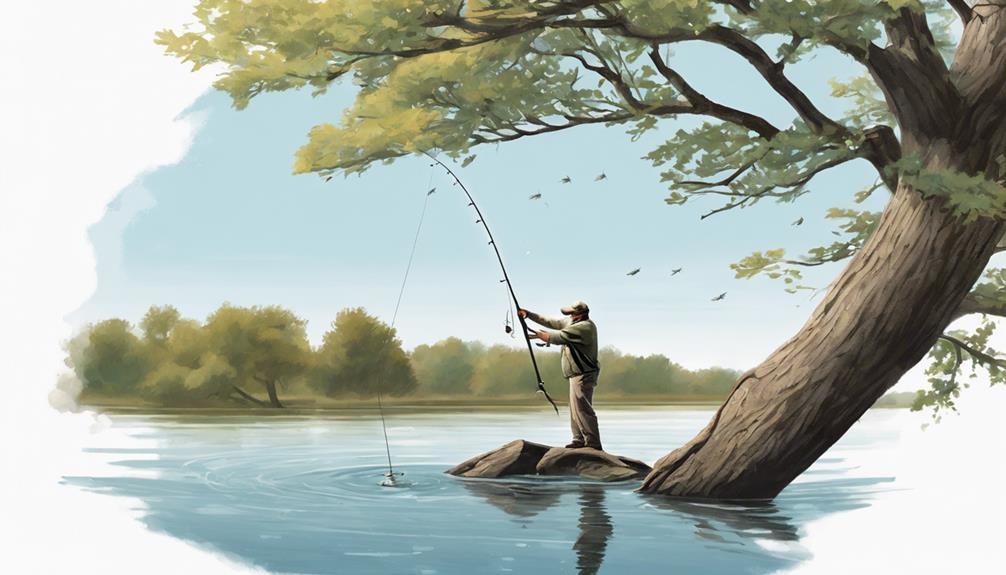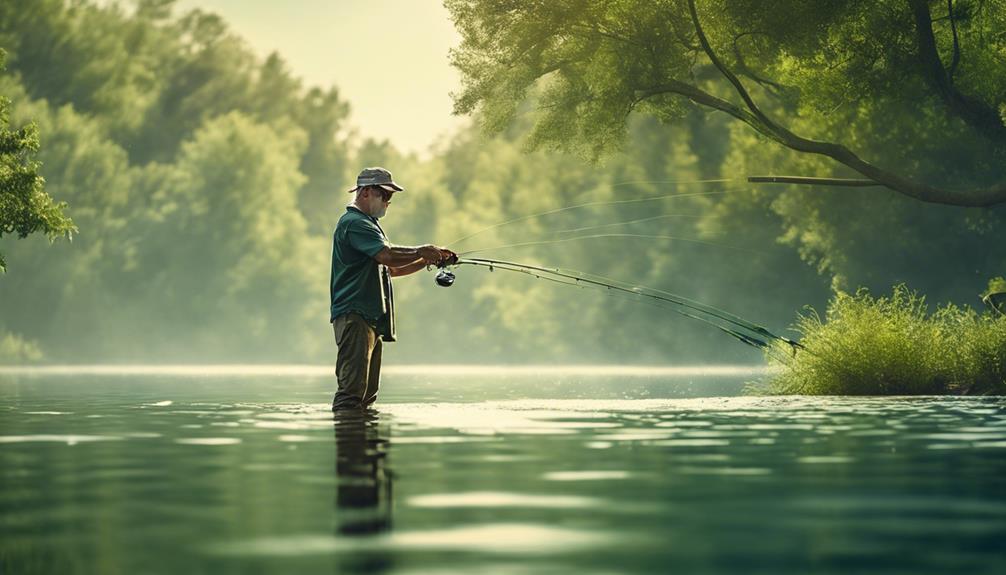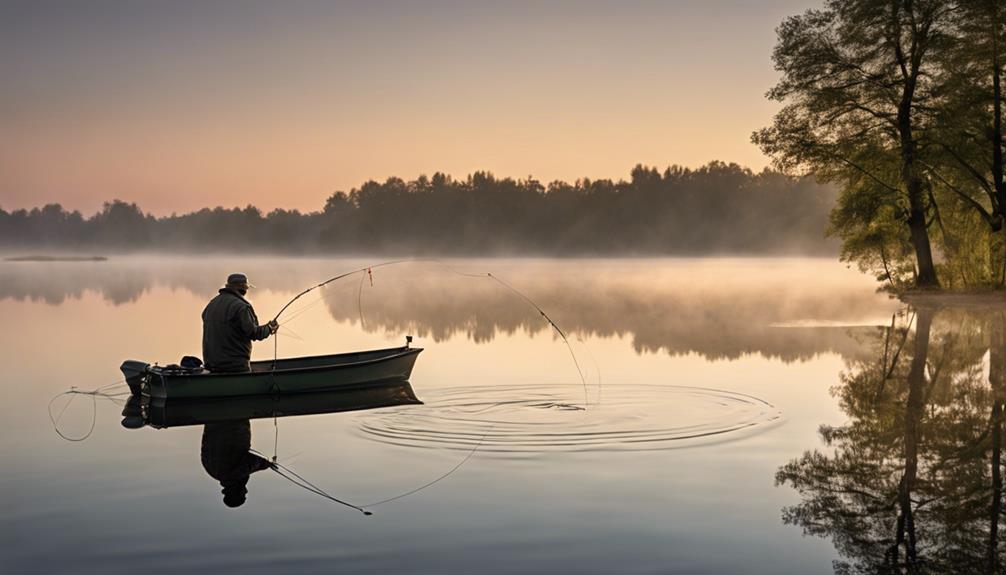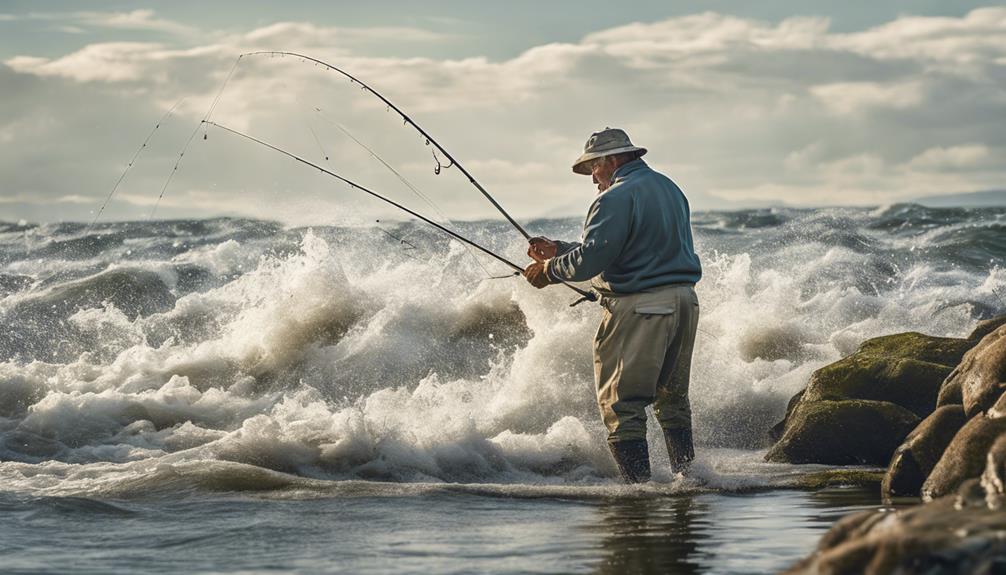When it comes to reeling in those elusive large mouth bass, it's essential to remember that patience is indeed a virtue. But what if there were strategies that could help you enhance your chances of a successful catch without waiting endlessly for a bite?
From mastering seasonal patterns to honing your casting accuracy, there are proven techniques that can elevate your bass fishing game. Stay tuned to discover how tweaking your approach can make a significant difference in your next fishing excursion.
Seasonal Patterns for Bass Fishing
Understanding the seasonal patterns of bass fishing can greatly enhance your chances of success on the water. In spring, bass are focused on spawning. This is a crucial time as they're more concentrated in specific areas such as shallow waters near the shore. Targeting these areas with soft plastic lures or jigs can yield great results during this period.
As summer arrives, bass transition to a feeding frenzy. They're more active and tend to move towards deeper waters in search of prey. Using crankbaits or spinnerbaits that mimic the movement of baitfish can be effective in enticing bites during this time. Look for structures like submerged rocks or fallen trees where bass might hide to ambush their prey.
Fall marks the migration period for bass as they move towards shallower waters in preparation for winter. This is an excellent time for topwater fishing using buzzbaits or poppers to imitate fleeing baitfish on the surface.
As winter sets in, bass become less active and tend to go into hibernation mode. They seek deeper, more stable waters with less fluctuation in temperature. Slow-moving lures such as jigs or live bait presented at a leisurely pace can attract sluggish winter bass.
Topwater Lure Techniques
As you focus on mastering your bass fishing skills, exploring topwater lure techniques can elevate your success on the water. When targeting large mouth bass with topwater lures, it's crucial to understand the dynamics of surface strikes and the importance of a stealth approach to entice the fish effectively.
Here are three key techniques to enhance your topwater bass fishing game:
- Buzzbait Brilliance: Utilizing a buzzbait can be highly effective in attracting bass due to its unique buzzing sound and surface-skimming action. Cast your buzzbait near structures like docks or overhangs, and reel it in steadily to create a commotion on the surface that mimics a distressed prey. Be prepared for explosive surface strikes as bass aggressively attack this noisy intruder.
- Popper Precision: Employing a popper lure with its distinctive popping and splashing action can be irresistible to bass lurking below. The key to using a popper effectively is to cast it near cover or weed beds, let it rest for a few seconds, then impart a series of gentle pops to mimic a wounded baitfish. This stop-and-go technique often triggers reactive strikes from bass ready to pounce on an easy meal.
- Stealthy Approach: When using topwater lures, maintaining a stealthy approach is essential. Keep your movements and noise to a minimum, especially when casting near potential bass hideouts. This cautious strategy can prevent spooking the fish and increase your chances of enticing them to strike your topwater lure confidently.
Deepwater Jigging Methods
To enhance your success in targeting large mouth bass in deeper waters, mastering effective deepwater jigging methods is crucial. When it comes to deepwater jigging, proper lure selection is key. Opt for jigs that mimic the prey bass are feeding on in those depths, such as crawfish or baitfish. Vary the weight of your jigs based on the depth you're fishing at, ensuring they reach the desired depth level where bass are likely to be present.
Depth control is essential in deepwater jigging. Pay close attention to your sonar readings to locate the depth at which bass are holding. Adjust your jigging technique and the time it takes for your jig to sink to the desired depth. Maintaining proper line tension is crucial to detecting subtle bites when jigging in deeper waters. Stay in contact with your lure at all times, as this will help you feel even the slightest nibbles from bass.
When a bass strikes, a quick and precise hook set is vital. Practice setting the hook swiftly to ensure a solid connection with the fish. Remember, the deeper the water, the more important it's to set the hook decisively due to the increased stretch in the line. By mastering these deepwater jigging methods, you can significantly increase your chances of landing large mouth bass in deeper waters.
Flipping and Pitching Techniques
Mastering flipping and pitching techniques is essential for successfully targeting largemouth bass in shallower waters. These techniques allow you to precisely present your bait in tight spots where big bass often hide.
Here are three key points to consider when using flipping and pitching techniques:
- Precision Casting: When flipping or pitching, accuracy is crucial. Practice casting your bait accurately to specific targets such as fallen trees, docks, or weed edges where bass are likely to be lurking. By honing your casting skills, you increase your chances of enticing a strike from a largemouth bass.
- Boat Positioning: Proper boat positioning plays a significant role in successful flipping and pitching. Position your boat at a distance where you can effectively reach your target area without spooking the fish. By staying at the right distance, you can make accurate casts and keep your bait in the strike zone for longer, increasing your chances of a bite.
- Line Management: Maintaining proper line tension and control is vital when flipping and pitching. Keep your line taut to feel even the slightest bite, and be ready to set the hook quickly. Practice managing your line to avoid tangles and ensure smooth, accurate presentations to potential bass hideouts.
Sight Fishing Strategies
Positioning yourself strategically along the shoreline allows you to effectively spot and target large mouth bass using sight fishing strategies. When employing sight fishing techniques, a stealthy approach is crucial. Large mouth bass have keen senses and can easily be spooked by sudden movements or loud noises. By moving quietly and carefully along the water's edge, you increase your chances of staying undetected and not scaring away potential catches.
Wearing polarized glasses is another essential component of successful sight fishing. These specialized glasses help reduce glare on the water's surface, allowing you to see beneath the water's surface more clearly. With polarized glasses, you can spot large mouth bass hiding among aquatic vegetation, fallen trees, or other structures. This enhanced visibility gives you a significant advantage when targeting specific fish.
As you scan the water with your polarized glasses, look for any movement, shadows, or shapes that indicate the presence of large mouth bass. Once you have identified a potential target, make precise casts to present your bait or lure accurately. Patience is key during sight fishing, as you may need to wait for the bass to notice your offering and decide to strike.
Effective Live Bait Tips
When targeting large mouth bass using live bait, selecting the right type of bait can significantly impact your fishing success. Here are some effective live bait tips to help you increase your chances of landing a big catch:
- Live Bait Selection: Large mouth bass are known to be attracted to live baits such as nightcrawlers, shiners, and crayfish. When choosing live bait, opt for lively and healthy specimens to entice the bass effectively.
- Presentation: When presenting live bait to large mouth bass, it's crucial to mimic natural movements. Allow the bait to move naturally in the water to appear more appealing to the bass. Avoid excessive jerking or sudden movements that may scare the fish away.
- Baitcasting Reel Advantages, Disadvantages: Using a baitcasting reel for live bait fishing offers greater accuracy and control over your cast. It allows you to target specific areas where large mouth bass are likely to hide. However, baitcasting reels require more skill to master compared to spinning reels, as they're prone to backlash if not handled correctly. Practice casting with a baitcasting reel to improve your accuracy and reduce the risk of backlashes while using live bait for large mouth bass fishing.
Casting Accuracy Tricks

To enhance your casting accuracy when targeting large mouth bass, focus on your casting angle and trajectory for precise bait placement. Precision casting is crucial for enticing large mouth bass to strike. When casting, aim to land your bait within a specific target zone rather than just near it. This involves not only the distance accuracy but also the direction in which you cast.
One trick to improve your precision casting is to practice casting at different angles. By mastering various casting angles, you'll be able to adapt to different fishing scenarios and environments. Experiment with casting parallel to the shoreline, perpendicular to structures, or even casting under overhanging vegetation. Each scenario requires a different angle and trajectory to deliver your bait accurately.
Another tip for enhancing your casting accuracy is to pay attention to your arm motion. Smooth, controlled movements will result in more accurate casts compared to jerky or rushed motions. Focus on the fluid motion of your arm and wrist to generate the right amount of power and finesse needed for precise bait placement.
Night Fishing Tactics
Ever wondered how to adjust your fishing techniques for optimal success during the night when targeting large mouth bass? Night fishing for large mouth bass can be an exciting and productive experience if you know the right tactics to employ. Here are some tips to help you improve your night fishing game:
- Pay Attention to the Moon Phase: Understanding the moon phase can significantly impact your night fishing success. During a full moon, bass tend to feed more actively, so consider planning your night fishing trips around this lunar phase. On the other hand, during a new moon when it's darker, bass may be more cautious and harder to catch.
- Utilize Artificial Lighting: Using artificial lighting strategically can attract baitfish, which in turn will draw in large mouth bass. Submersible fishing lights or floating lanterns can help create a feeding frenzy by attracting insects and smaller fish, ultimately luring in bass to your location.
- Fish Near Structure: Large mouth bass are known to seek cover and structure, especially during the night when visibility is limited. Target areas near submerged trees, docks, rocks, or underwater vegetation where bass are likely to hide and ambush their prey. Casting your lure close to these structures increases your chances of enticing a strike from a bass lurking in the shadows.
Frequently Asked Questions
What Are the Best Types of Water Bodies to Fish for Large Mouth Bass?
When looking for the best types of water bodies to fish for large mouth bass, consider topographical features and seasonal patterns. Different bodies of water offer unique advantages based on their depths, structures, and vegetation.
During certain seasons, bass may prefer shallower or deeper waters. By understanding these factors and adapting your fishing strategy accordingly, you can increase your chances of a successful catch.
How Can Anglers Locate Productive Fishing Spots in Unfamiliar Waters for Bass Fishing?
To locate productive fishing spots in unfamiliar waters for bass fishing, you can rely on your skills and experience. Use your knowledge of tackle selection and fishing techniques to explore different areas.
Pay attention to bait preferences and seasonal patterns to increase your chances of success. By being observant and adaptable, you can identify promising spots and catch some big bass.
Trust in your abilities and enjoy the thrill of the chase.
Are There Any Specific Weather Conditions That Are Optimal for Catching Large Mouth Bass?
When trying to catch large mouth bass, remember that specific weather conditions can play a role in your success. Look for the best bait to use and consider the ideal time for fishing. Pay attention to factors like water temperature, cloud cover, and wind speed.
Large mouth bass tend to be more active during early morning or late evening. Experiment with different conditions to see what works best in your area.
What Are Some Common Mistakes That Beginners Make When Fishing for Large Mouth Bass?
When fishing for large mouth bass, beginners often make common mistakes that can affect their success. One of these errors isn't using proper techniques, such as casting too close to shore or not varying their retrieve speeds. These mistakes can result in missed opportunities to catch bass.
To improve your chances, focus on learning the right techniques and practicing them consistently to become a more skilled angler.
How Can Anglers Effectively Handle and Release Large Mouth Bass to Ensure Their Survival After Being Caught?
When handling and releasing large mouth bass, it's crucial to be gentle and quick. Support their body properly and avoid touching their gills. Keep them in the water as much as possible, especially for larger fish.
If you need to remove the hook, do it swiftly and with care. Once it's time to release, gently place the bass back in the water, allowing it to swim away on its own for its conservation and survival.
Conclusion
Now that you have learned these effective strategies for large mouth bass fishing, you'll be ready to tackle any fishing expedition with confidence.
Remember to adjust your techniques based on seasonal patterns, utilize topwater lures, try deepwater jigging, practice flipping and pitching, use live bait effectively, improve your casting accuracy, and even try night fishing for a new challenge.
Keep honing your skills and enjoy the thrill of reeling in those big bass!



